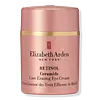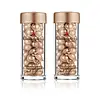What's inside
What's inside
 Key Ingredients
Key Ingredients

 Benefits
Benefits

 Concerns
Concerns

No concerns
 Ingredients Side-by-side
Ingredients Side-by-side

Water
Skin ConditioningGlycerin
HumectantButylene Glycol
HumectantCyclopentasiloxane
EmollientCetyl Ricinoleate
EmollientDimethicone
EmollientCetearyl Methicone
Skin ConditioningGlyceryl Stearate
EmollientPEG-100 Stearate
Squalane
EmollientAcrylates/C10-30 Alkyl Acrylate Crosspolymer
Emulsion StabilisingBHT
AntioxidantC30-45 Alkyl Dimethicone
Skin ConditioningCarbomer
Emulsion StabilisingCeramide AP
Skin ConditioningCeramide EOP
Skin ConditioningCeramide NP
Skin ConditioningCetearyl Alcohol
EmollientCholesterol
EmollientDimethicone/Vinyl Dimethicone Crosspolymer
Skin ConditioningDisodium EDTA
Fraxinus Excelsior Bark Extract
Skin ConditioningHydroxyethyl Acrylate/Sodium Acryloyldimethyl Taurate Copolymer
Emulsion StabilisingIsohexadecane
EmollientMica
Cosmetic ColorantNiacinamide
SmoothingPalmitoyl Tetrapeptide-7
Skin ConditioningPalmitoyl Tripeptide-1
Skin ConditioningPanthenol
Skin ConditioningPhytosphingosine
Skin ConditioningPolymethyl Methacrylate
Polysorbate 20
EmulsifyingPolysorbate 60
EmulsifyingRetinol
Skin ConditioningSilanetriol
Sodium Lauroyl Lactylate
EmulsifyingTocopheryl Acetate
AntioxidantTromethamine
BufferingXanthan Gum
EmulsifyingBenzoic Acid
MaskingChlorphenesin
AntimicrobialPhenoxyethanol
PreservativeSorbic Acid
PreservativeCI 77491
Cosmetic ColorantCI 77891
Cosmetic ColorantWater, Glycerin, Butylene Glycol, Cyclopentasiloxane, Cetyl Ricinoleate, Dimethicone, Cetearyl Methicone, Glyceryl Stearate, PEG-100 Stearate, Squalane, Acrylates/C10-30 Alkyl Acrylate Crosspolymer, BHT, C30-45 Alkyl Dimethicone, Carbomer, Ceramide AP, Ceramide EOP, Ceramide NP, Cetearyl Alcohol, Cholesterol, Dimethicone/Vinyl Dimethicone Crosspolymer, Disodium EDTA, Fraxinus Excelsior Bark Extract, Hydroxyethyl Acrylate/Sodium Acryloyldimethyl Taurate Copolymer, Isohexadecane, Mica, Niacinamide, Palmitoyl Tetrapeptide-7, Palmitoyl Tripeptide-1, Panthenol, Phytosphingosine, Polymethyl Methacrylate, Polysorbate 20, Polysorbate 60, Retinol, Silanetriol, Sodium Lauroyl Lactylate, Tocopheryl Acetate, Tromethamine, Xanthan Gum, Benzoic Acid, Chlorphenesin, Phenoxyethanol, Sorbic Acid, CI 77491, CI 77891
Dicaprylyl Carbonate
EmollientCoco-Caprylate/Caprate
EmollientDimer Dilinoleyl Dimer Dilinoleate
EmollientTetrahexyldecyl Ascorbate
AntioxidantTocopheryl Acetate
AntioxidantC12-15 Alkyl Benzoate
AntimicrobialCaprylic/Capric Triglyceride
MaskingCeramide NP
Skin ConditioningCeramide Ns
Skin ConditioningDiethylhexyl Syringylidenemalonate
Skin ProtectingGlyceryl Dioleate
EmollientHelianthus Annuus Seed Oil
EmollientOlea Europaea Fruit Oil
MaskingPersea Gratissima Oil
Skin ConditioningPhytosphingosine
Skin ConditioningPhytosterols
Skin ConditioningPropylene Glycol Dicaprylate/Dicaprate
EmollientSclareolide
MaskingTocopherol
AntioxidantTriolein
Skin ConditioningPhenoxyethanol
PreservativeDicaprylyl Carbonate, Coco-Caprylate/Caprate, Dimer Dilinoleyl Dimer Dilinoleate, Tetrahexyldecyl Ascorbate, Tocopheryl Acetate, C12-15 Alkyl Benzoate, Caprylic/Capric Triglyceride, Ceramide NP, Ceramide Ns, Diethylhexyl Syringylidenemalonate, Glyceryl Dioleate, Helianthus Annuus Seed Oil, Olea Europaea Fruit Oil, Persea Gratissima Oil, Phytosphingosine, Phytosterols, Propylene Glycol Dicaprylate/Dicaprate, Sclareolide, Tocopherol, Triolein, Phenoxyethanol
Ingredients Explained
These ingredients are found in both products.
Ingredients higher up in an ingredient list are typically present in a larger amount.
Ceramide NP is a type of ceramide and formally known as ceramide 3.
Ceramides are intercellular lipids naturally found in our skin that bonds dead skin cells together to create a barrier. They are known for their ability to hold water and thus are a great ingredient for dry skin.
Ceramides are an important building block for our skin barrier. A stronger barrier helps the skin look more firm and hydrated. By bolstering the skin ceramides act as a barrier against irritating ingredients. This can help with inflammation as well.
If you would like to eat ceramides, sweet potatoes contain a small amount.
Read more about other common types of ceramides here:
Ceramide AP
Ceramide EOP
Phenoxyethanol is a preservative that has germicide, antimicrobial, and aromatic properties. Studies show that phenoxyethanol can prevent microbial growth. By itself, it has a scent that is similar to that of a rose.
It's often used in formulations along with Caprylyl Glycol to preserve the shelf life of products.
Phytosphingosine is a phospholipid naturally found in our skin as a building block for ceramides.. It helps moisturize, soothe, and protect skin.
Phytosphingosine contributes to your skin's natural moisturizing factor (NMF). The NMF is responsible for hydration, a strong barrier, and plasticity. Our NMF decreases with age. Increasing NMF leads to more healthy and hydrated skin.
Studies show products formulated with NMF ingredients help strengthen our skin's barrier. Having a healthy skin barrier reduces irritation and increases hydration. Our skin barrier is responsible for having plump and firm skin. It also helps protect our skin against infection, allergies, and inflammation.
Fun fact: Phytosphingosine is abundant in plants and fungi.
More ingredients that help boost collagen in skin:
Learn more about PhytosphingosineTocopheryl Acetate is AKA Vitamin E. It is an antioxidant and protects your skin from free radicals. Free radicals damage the skin by breaking down collagen.
One study found using Tocopheryl Acetate with Vitamin C decreased the number of sunburned cells.
Tocopheryl Acetate is commonly found in both skincare and dietary supplements.
Learn more about Tocopheryl Acetate